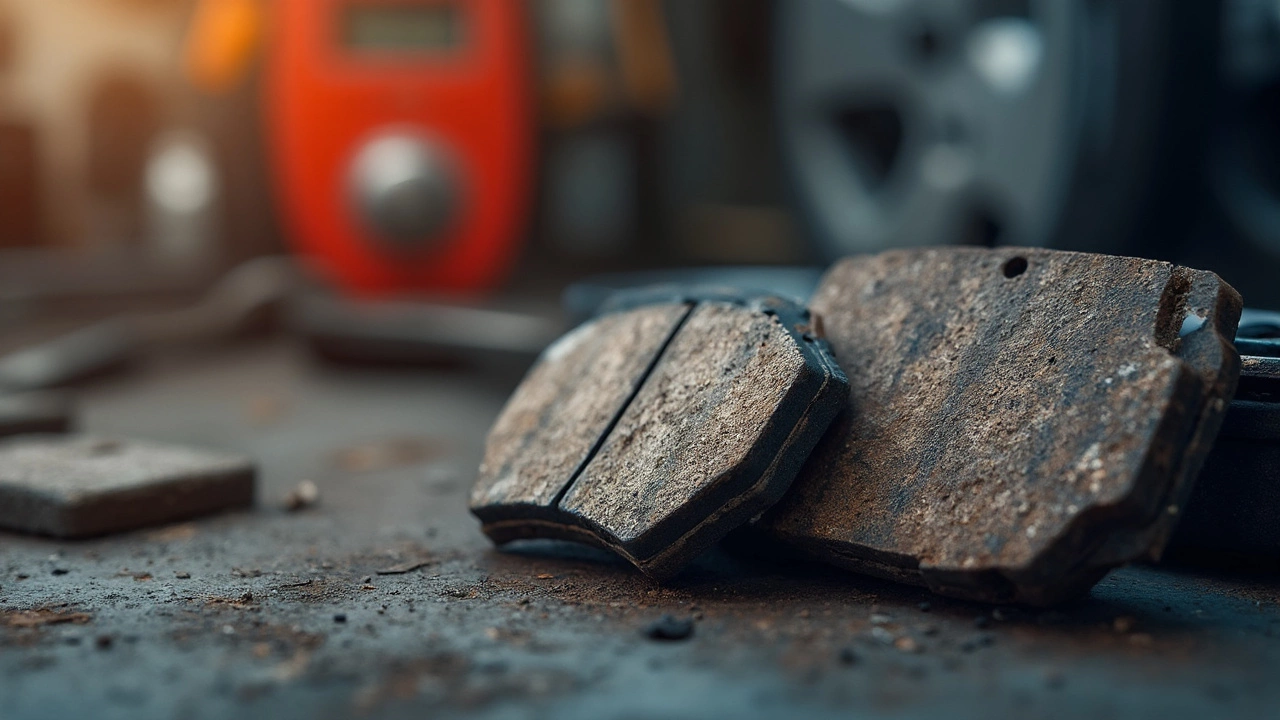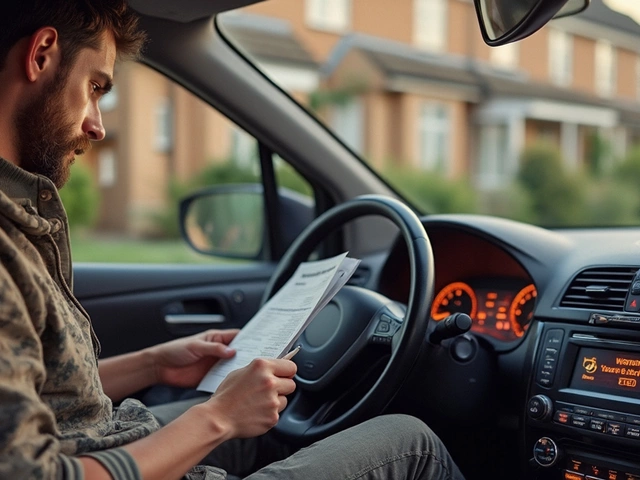Ever wondered if it's okay to drive when your brake pads are crying for help? Well, the short answer is probably not. Danger lurks when brake pads wear thin, as they’re a critical part of your car's stopping ability. Bad brake pads can mean reduced stopping power, and nobody wants to gamble with safety like that.
Now, how do you know if your brake pads are past their prime? Listen and look. If you hear squealing or grinding sounds when you hit the brakes, or if your brakes just don’t feel as responsive anymore, these are red flags. A worn-out brake pad can be a warning sign that should never be ignored.
Driving with bad brake pads isn't just a piece of cake; it can lead to costly damage too. You might end up wearing out your rotors or even lose braking ability—yikes! That’s why keeping up with regular maintenance is key. Making sure your brakes are in top shape can keep you safe and save you a bit of cash in the long run.
- The Role of Brake Pads
- Signs of Bad Brake Pads
- Risks of Driving with Worn-out Brakes
- Maintaining Your Brake System
The Role of Brake Pads
When you think about staying safe on the road, your mind probably goes straight to seatbelts and airbags, right? But sneaking right under your nose—okay, your car—are the brake pads. These unsung heroes work behind the scenes every time you drive.
The basic gig of brake pads is to press against the brake rotor to create the friction needed to stop your wheels. So, when you hit the brake pedal, it's like barking an order to these pads to get to work and help you stop smoothly and safely. Without them functioning properly, you're basically putting the brakes on your safety.
Now, what are these pads even made of, you may ask? They come in different flavors: organic, semi-metallic, and ceramic are the big three. Each has its own perks. Like, ceramic brake pads are quiet and durable but come at a steeper price, while semi-metallic pads are cheaper and great for performance, though they can be a bit noisy.
You might not realize it, but your driving habits also determine how long your brake pads last. Generally, they can last anywhere from 30,000 to 70,000 miles, but heavy city traffic or constant stop-and-go can wear them out faster. Checking them routinely and upgrading to quality pads can really pay off, helping you avoid sudden heart-thumping moments on the road.
Have you noticed how frequently your brakes take a hit, especially in city driving? A survey, shown below, gives you an idea of how brake pad wear varies with driving conditions:
| Driving Condition | Brake Pad Life (Miles) |
|---|---|
| Highway Driving | 70,000 |
| City Traffic | 30,000 - 40,000 |
| Mixed Driving | 50,000 |
Still, no matter the type, every driver should know that properly working brake pads are crucial. When they start to fail, it’s not just a hassle—it’s a hazard. So, replace them when needed, keep them maintained, and breathe easy knowing that you’re keeping your car's safety features in check.
Signs of Bad Brake Pads
Recognizing when your brake pads are on their last legs isn't as tricky as it may seem. You just need to pay attention to both new and lingering sounds, as well as how your car behaves when you stop.
First off, if you hear a high-pitched screeching noise every time you brake, that’s often the wear indicator on your brake pads. It's a built-in squeal that’s designed to get your attention when the pads have worn down.
Another telltale sign is a grinding noise, which can be more serious. This often happens when the pads are completely worn down, and the metal caliper is making contact with the brake rotor—definitely not something you want. If you feel vibrations or a pulsating brake pedal, that could indicate warped rotors resulting from neglected bad brake pads.
Your car might also be trying to tell you something if it takes longer to stop than usual or if you have to press the pedal harder. Anything less than crisp braking should ring alarm bells.
Here’s a quick list to keep an eye out for:
- Squealing noise as a warning sign
- Grinding when not serviced on time
- Pulsating or vibrating brake pedal
- Longer stopping distances—dangerous both on highway and city roads
- Visual wear—if you peek through the wheel spokes and see less than a quarter-inch of pad, it’s time for a change
Staying alert to these signs can save you a heap of trouble and make sure you don’t find yourself in unsafe driving situations. Always prioritize maintaining your car's braking system to avoid unexpected and often costly repairs later on.

Risks of Driving with Worn-out Brakes
Picture this: you're cruising down the road, and suddenly a squirrel darts out. You slam on the brakes, and... nothing. That's a nightmare scenario when you're dealing with worn-out brake pads. These pads are crucial for stopping, so if they're not working properly, you could be in trouble.
First off, bad brake pads mean longer stopping distances. If you have to slam your brakes and it takes forever to stop, you're at risk of an accident. It's particularly nasty in emergencies or bad weather when every inch counts. Imagine the mess on a rainy road if your brakes are shot.
Then there's the whole damage thing. Keeping bad brake pads can lead to brake rotor damage—because metal grinding on metal never ends well. Replacing rotors is costly, way more than just swapping out the pads when it's time.
Plus, your entire brake system can heat up and fail. Scary stuff, right? A hot brake system loses effectiveness, and you could find yourself losing control.
"Ignoring brake maintenance is like playing Russian roulette with your vehicle," says James Blackstone, a renowned automotive safety expert.
For the wallet-watchers, think about the repair costs. Delaying brake maintenance is like throwing money out the window. Fixing rotors, calipers, or—heaven forbid—a whole brake system costs way more than a set of new pads.
In short, keeping your brake pads in good shape isn’t just about staying safe; it’s about avoiding costly repairs and ensuring your vehicle lasts longer.
Maintaining Your Brake System
Keeping your brake system in tip-top shape isn’t just about avoiding those nasty squeals and squeaks; it’s about making sure you’re safe on the road. Regular check-ups are your best friend here. They help catch problems early, saving you from the big bucks down the line.
First things first, make sure you’re checking your brake pads regularly. Most experts recommend doing this every 10,000 miles or at least once a year. If you're unsure, have a mechanic take a look during your routine service.
Ever thought of doing a simple brake test while driving? Find an empty stretch of road, and gently tap your brakes. If you feel a wobble or hear noise, it’s time for a check-up.
- Listen for any unusual noises such as grinding or squealing.
- Look for warning lights on your dashboard.
- Feel the brake pedal—does it feel spongy or hard?
- Check for brake fluid leaks; spotting any on the ground under your car is usually a bad sign.
Changing your brake fluid is another key point. Over time, it absorbs moisture which can lead to corrosion. Aim to replace it every two years. Plus, use the right type of brake fluid as specified in your car’s manual.
Invest in quality brake pads rather than the cheapest ones out there. They last longer and provide better stopping power, reducing the chances of wear on other parts like your rotors.
Here’s a startling fact: a study found that 25% of car accidents linked to vehicle issues involved faulty brakes. Scary, right? It goes to show that a bit of maintenance goes a long way.




